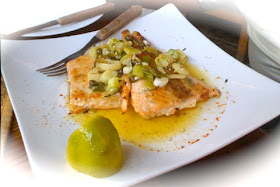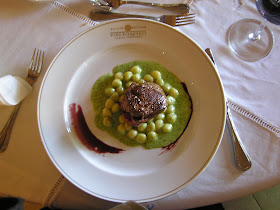Our Las Américas travels through Chile (Arica to Puerto Monte – then later through the Chilean Patagonia) took us through all fifteen regions (administrative divisions) of Chile. Based on our travels there are some Chilean culinary experiences that I would like to share.
First, I cannot think of Chilean Cuisine without noting it was influenced by European and native Indian food traditions. Chile's culinary history was enriched by Araucanian/Mapuche and Inca traditions (Andean Cuisine). Then with the arrival of the Spaniards in Chile, Spanish Cuisine became infused with local Chilean ingredients. Later other European countries, especially Germany made an impact on what is now Chilean Cuisine. Another major impact on Chilean Cuisine is its wine regions. Chile has one of the largest productions of wine in the world. The result is, wine either enhances or accompanies Chilean food.
Another great influence on the development of Chilean Cuisine is its unique physical geography. The entire landmass of Chile is positioned between the Pacific Ocean and the Andes Mountains. Chile stretches from Peru in the north to the tip of South America, with five primary geographic regions. These regions are Far North, Near North, Central, South and Far South. This results in a wide variation in climatic conditions and agricultural produce.
The northern regions are semi-tropical to tropical, making it ideal for growing mangoes, papayas, lúcumas, chirimoyas (custard apples). The central region of Chile has a Mediterranean climate making it perfect for growing fruits and vegetables. Here you will find fruits such as grapes, melons, watermelons and avocados.
The northern regions are semi-tropical to tropical, making it ideal for growing mangoes, papayas, lúcumas, chirimoyas (custard apples). The central region of Chile has a Mediterranean climate making it perfect for growing fruits and vegetables. Here you will find fruits such as grapes, melons, watermelons and avocados.
 |
| Wonderful Chilean Fruit!! © Spaswinefood |
The climate in the southern region is suited for growing grains, apples, cherries, plums and dairy and beef farming. Still further south in Patagonia, you will find sheep farming.
 |
| Sheep Farming in Chilean Patagonia © Spaswinefood |
 |
| Octopus, Indómita Viña Restaurant, Casablanca Valley © Spaswinefood |
 |
| Salmon, La Tribu Restaurant, Cascada de Las Animas © Spaswinefood |
Seafood Entree at Trutti Restaurant, Valparisio © Spaswinefood
|
 |
| Salmon, Fogón Puyehue Restaurant © Spaswinefood |
 | ||
Lunch at Turri Restaurant, Valparisio © Spaswinefood
|
 |
| Pasta,Indómita Viña Restaurant, Casablanca Valley © Spaswinefood |
 |
| Steak, Bisquertt Viña Restaurant, Cochagua Valley © Spaswinefood |
 |
| Omelet, Fogón Puyehue Restaurant, Puyehue © Spaswinefood |
Chilean desserts are popular and are often quite sweet (made from caramelized condensed milk).
 |
| Dessert, Viu Manet Viña Restaurant, Colchagua Valley © Spaswinefood |
Snacks are also quite popular in Chile, with empanadas and sandwiches being the most popular. The best empanadas we had on our trip was at Empanadas Florence in Antofagasta.
There are typically four meals a day (breakfast, lunch, "once" and dinner). Breakfast (Desuyuno) is typically a small meal. Lunch (Amuerzo) is a large meal, normally eaten between one and two in the afternoon. Dinner (Cena ) the last meal of the day comes late, around nine or later. Once (eleven) is a snack between lunch and dinner, generally between four and six, most commonly around five. Sometimes "once" can be quiet fancy, similar to high tea. "Once" is quite popular in many Chilean restaurants.
South To The Central Valley Via The Coastal Route
Our travels through Northern Chile took us first on a coastal desert journey, starting at Arica (camped). Arica was delightful after a long drive along the coastal route in Peru.
 |
| In Arica we watched Chilean folkloric dancing © Spaswinefood |
After a restful stop in Arica, then it was onto Cuya (camped at Pta. Camarones), Antofagasta (Hotel del Sur), Taltal (Cabañas Hueso) and next stopping just north of Los Vilos (camped).
Arica to Los Vilos we did most of own cooking. As we drove south we encountered roadside shops selling sweets (dulces), aceitunas (olives), fruit and vegetables.
Central Chile
After Los Vilos it was a long drive to San Fernando (Hotel Espanola) and Santa Cruz where we enjoyed some of the best cuisine and wine in the world. In Santa Cruz we stayed at Entre Viñas (a wonderful boutique hotel). This hotel treated both us and our pets royally!
 |
| Fantastic Breakfasts, Entree Viñas © Spaswinefood |
Wine Visiting in the Colchagua Valley
Our overall best Chilean wine touring experience was in the Colchagua Valley. All the wineries are so easy to visit, at a very relaxed pace. We took three days to tour the wineries in this area. There are many good wineries, restaurants and hotels in this wine region.
Viña Lapostelle
Viña Las Niñas
After wine tasting at Viña Las Niñas we had a picnic lunch in their beautiful picnic area.
 |
| Who would not enjoy a picnic lunch in such a beautiful setting? |
 |
| The "Best" Wine Server © Spaswinefood |
 |
| Best Wine Tasting Presentation in all of Chile!! © Spaswinefood |
With such royal treatment how could we not enjoy wine tasting at MontGras. Their wines are also great. MontGras recommended Viñas Bisquett for lunch. This was an excellent recommendation.
Viñas Bisquertt
Bisquertt was mostly a dining experience for us. They did however pair wine with the five course lunch. Their wonderful chief prepared a great vegetarian lunch for me. It was quite a memorable experience.
Viña Montes
Viña Montes La Finca De Apalta is a beautiful winery that promotes eco-friendly practices.
Any one traveling to Chile should not miss the Colchagua Valley Wine Region.
Central Valley Revisited
February 2010, we visited the city of Valparaíso and the Casablanca Valley. Then later in April we crossed back into Chile at Pucón and drove northwards to Valparaíso Province and the Santiago area. Here are some culinary highlights from these trips.
Viña del Mar, Valparaíso Province is a beautiful seaside town just west of the Casablanca Valley.
Viña Del Mar
|
Lunch in a restaurant just north of Viña Del Mar
|
Laguna Verde, Valparaíso Province is just south of the city of Valparaíso.
 |
| Preparing dinner at camp © Spaswinefood |
South of Santiago de Chile we visited the Maipo Valley where we discovered some culinary treats at La Tribu Restaurant, Cascada de Las Animas.
 |
View from La Tribu Restaurant, Cascada de Las Animas © Spaswinefood
|
 |
Southern Chile
Driving south to the Lake District we visited Recinto (Cabañas), Pinto (camped), Rio Bio Bio (camped at Naciemento of Rio Bio Bio), Parque National Conguillo (camped), Villarrica (Cabañas Bungalowlandia), Puerto Varas (camped at Playa Niklitschek), Ensenada (camped at Camping Montanya) and Puyehue (Cabañas Copihues). John explored trout fishing at Lago Villarrica, and Puyehue. From Puyehue we crossed into Argentina and onto Bariloche.
 |
| Trout stuffed with quinoa © Spaswinefood |
Pueyehue
 |
| Do you want Coke? Yes! © Spaswinefood |
On Chilean election day we visited Fogón Puyehue Restaurant, Puyehue. They were not allowed to sell alcohol on that day. The waiter put an empty coke bottle on the table and discretely served us some wine. We had a great lunch.
Picarquin Campground
 |
| Chilean wine and stirfry © Spaswinefood |
 |
| Another great dinner with a bottle of Undarraga at campsite © Spaswinefood |
Far South
Chilean Patagonia and Tierra Del Feugo we visited after Bariloche, Argentina. After leaving Bariloche we traveled south on Argentina (Ruta 40). During the drive south we re-entered Chile in Patagonia en route to Ushuaia, Tierra Del Feugo (a part of which is also in Chile). This time we visited Parque Nacional Torres Del Paine (Refugio Laguna Amargo) and Punta Arenas (Donde Juan Campsite and Hostal Bulnes).
 |
| Spectacular Torres Del Paine © Spaswinefood |
 |
| Dinner, El Refugio Almargo, Torres Del Paine © Spaswinefood |
 |
| Punta Arenas © Spaswinefood |
Punta Arenas, the largest town in Chile's Far South has a great selection of restaurants. La Tasca, a Spanish restaurant on the main plaza is well worth a visit. We enjoyed dining there.
In conclusion, Chilean Cuisine has lots of variation and it can be quite delicious. Clearly, our Chilean Culinary Travels were very much influenced by, our desire to visit as many Chilean wineries as possible. I hope to return soon!! I invite you to join me in my travels in Chile and elsewhere at Spaswinefood.
Sharon
Tasting Memories from the Las Américas Trip
February 2011
© Spaswinefood
Spaswinefood earlier posts on the Chilean Wine Regions were:















































No comments:
Post a Comment